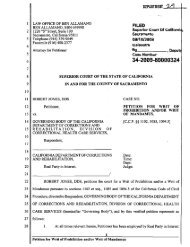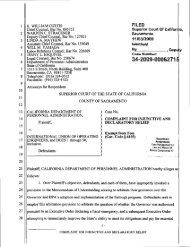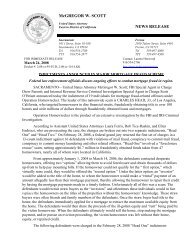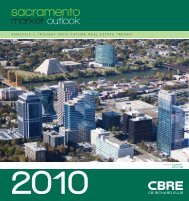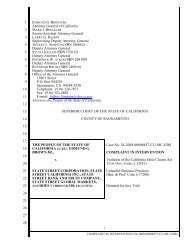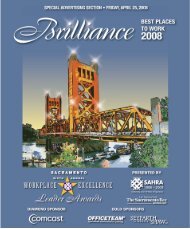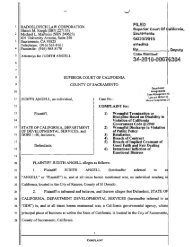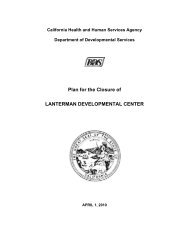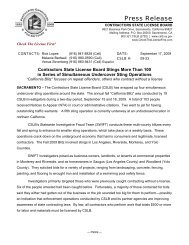Hispanic Hispanic los hispanos - The Sacramento Bee
Hispanic Hispanic los hispanos - The Sacramento Bee
Hispanic Hispanic los hispanos - The Sacramento Bee
Create successful ePaper yourself
Turn your PDF publications into a flip-book with our unique Google optimized e-Paper software.
4<br />
<strong>Hispanic</strong> Literature & Storytelling<br />
Like writers, <strong>Hispanic</strong> Americans are a diverse group<br />
By Kathy Dahlstrom<br />
Isabel Allende grew up in Chile in the 1950s. Gary Soto's<br />
childhood home was next to a junkyard in Fresno,<br />
California. Colombian-born Laura Restrepo rarely went<br />
to school because her family traveled so much.<br />
<strong>Hispanic</strong> authors come from many different backgrounds.<br />
And what they write about is just as varied.<br />
<strong>The</strong>ir work ranges from personal experiences to<br />
news reports, from thoughtful poetry and whimsical<br />
fiction to the dark crime and mystery writing known<br />
as "Latin Noir."<br />
Sure, they are linked by language and the part of the<br />
world they or their ancestors came from. But with 22<br />
different countries of origin, the growing <strong>Hispanic</strong> or<br />
Latino population is one of the most diverse groups in<br />
the United States.<br />
While many are new to this country—and may not<br />
even be citizens—others trace their roots way back.<br />
Some are Americans because their land was taken over<br />
by the U.S. government.<br />
Under the Treaty of Hidalgo in 1848, which ended the<br />
Mexican War, Mexico handed over California, Utah,<br />
Nevada and parts of Colorado, Wyoming, New Mexico<br />
and Arizona to the United States.<br />
Other <strong>Hispanic</strong>s came here for political freedom,<br />
better education opportunities, or better work.<br />
Some writers create their work in Spanish and it is<br />
then translated into English. Others tell stories in<br />
English or weave both languages together into colorful<br />
Spanglish.<br />
<strong>Hispanic</strong> Americans aren't even all the same race.<br />
<strong>The</strong>y are White, Black, Native American, Asian and<br />
multi-racial.<br />
U.S. Census Bureau reports on the <strong>Hispanic</strong> population<br />
show a fast-growing but very diverse group.<br />
<strong>The</strong> Census predicts that Latinos/<strong>Hispanic</strong>s will be one<br />
quarter of the U.S. population by 2050, representing<br />
67 million people.<br />
In 2002 the Census Bureau reported <strong>Hispanic</strong>s had<br />
become the nation's largest minority group at 13.3<br />
percent of the population, and by June 2005 the<br />
<strong>Hispanic</strong> population had grown to 41.3 million. <strong>The</strong><br />
rate of population growth for <strong>Hispanic</strong>s was almost<br />
three times that for the total population in 2003-2004<br />
and accounted for about one-half of U.S. population<br />
growth since the year 2000.<br />
But within that group there is tremendous variety.<br />
<strong>Hispanic</strong>s are not a monolithic group. Among the<br />
<strong>Hispanic</strong> population, two-thirds (66.9 percent) were<br />
Mexican, 14.3 percent Central and South American, 8.6<br />
percent Puerto Rican, 3.7 percent Cuban and the<br />
remaining 6.5 percent were of other origins.<br />
U.S. <strong>Hispanic</strong>s tended to live in the West (44.2 percent)<br />
and South (34.8 percent) but many chose the<br />
Northeast (13.3 percent) and Midwest (7.7 percent).<br />
Nearly half of all <strong>Hispanic</strong>s lived in big cities, 34.4<br />
percent were under age 18 and two in five were<br />
foreign born.<br />
Al igual que <strong>los</strong> escritores, <strong>los</strong> hispanoamericanos<br />
conforman un grupo diverso<br />
Author & Journalist Jorge Ramos<br />
Por Kathy Dahlstrom<br />
Isabel Allende creció en Chile en la década de 1950.<br />
Gary Soto pasó su infancia en una casa situada junto a<br />
un depósito de chatarra en Fresno, California. Laura<br />
Restrepo, nacida en Colombia, rara vez asistió a la<br />
escuela cuando niña porque su familia viajaba muy<br />
frecuentemente.<br />
Hay autores <strong>hispanos</strong> cuyos antecedentes personales<br />
son tan diversos como <strong>los</strong> temas de sus obras, que van<br />
desde la narración de experiencias personales hasta<br />
el reportaje de noticias, desde la poesía y la ficción<br />
imaginativa hasta las oscuras historias de crimen y misterio<br />
conocidas como “el noir latino”.<br />
Ciertamente, a estos autores <strong>los</strong> une el idioma y la<br />
región del mundo en la cual el<strong>los</strong> o sus antepasados<br />
nacieron, pero hay que tener presente que la creciente<br />
población hispana o latina de <strong>los</strong> Estados Unidos procede<br />
de 22 países diferentes y constituye por tanto<br />
uno de <strong>los</strong> grupos más diversos en este país.<br />
Si bien muchos <strong>hispanos</strong> han llegado recientemente a<br />
este país y muchos de el<strong>los</strong> quizás no han adquirido<br />
aún la ciudadanía, en cambio otros tienen antiguas<br />
raíces aquí. De acuerdo con el tratado de Hidalgo de<br />
1848, que puso fin a la guerra con México, este país<br />
entregó a <strong>los</strong> Estados Unidos <strong>los</strong> estados de California,<br />
Utah, Nevada y partes de Colorado, Wyoming, Nuevo<br />
México y Arizona.<br />
La diversidad entre escritores <strong>hispanos</strong> también es<br />
manifiesta. Algunos escriben en español y sus obras<br />
luego son traducidas al inglés. Otros cuentan historias<br />
en inglés o combinan este idioma y el español en lo<br />
que se denomina “Spanglish”.<br />
No hay uniformidad ni siquiera en cuanto a la raza,<br />
porque <strong>los</strong> latinos en este país son blancos, afro latinos,<br />
americanos nativos y asiáticos, o pertenecen a<br />
más de un grupo racial.<br />
Informes de la Oficina del Censo de <strong>los</strong> Estados Unidos<br />
muestran que la población hispana es un grupo de rápido<br />
crecimiento y sumamente diverso. La Oficina del<br />
Censo estima que en el año 2050 la población latina llegará<br />
a ser una cuarta parte de la población total del<br />
país, con 67 millones de personas. En 2002 esta oficina<br />
informó que <strong>los</strong> <strong>hispanos</strong> habían llegado a ser la<br />
minoría más numerosa de la nación con el 13.3 por<br />
ciento de la población total. En junio de 2005 el total<br />
de <strong>hispanos</strong> ascendió a 41.3 millones. La tasa de crecimiento<br />
de la población hispana fue casi tres veces más<br />
alta que la de la población total en el período 2003-<br />
2004, y representó aproximadamente la mitad del crecimiento<br />
de la población del país desde el año 2000.<br />
Los <strong>hispanos</strong> no son un grupo monolítico sino que<br />
ofrecen una enorme variedad. Dos tercios de <strong>los</strong> <strong>hispanos</strong><br />
(66.9 por ciento) son mexicanos, 14.3 por ciento<br />
proceden de América Central y América del Sur, 8.6<br />
por ciento son puertorriqueños, 3.7 por ciento son<br />
cubanos y el 6.5 por ciento restante tiene otros orígenes.<br />
Aunque <strong>los</strong> <strong>hispanos</strong> tienden a vivir en el oeste<br />
de <strong>los</strong> Estados Unidos (44.2 por ciento) y en el sur del<br />
país (34.8 por ciento), muchos eligieron el nordeste<br />
(13.3 por ciento) y la región central del oeste (7.7 por<br />
ciento). Casi la mitad de todos <strong>los</strong> <strong>hispanos</strong> vive en las<br />
ciudades principales. El 34.4 por ciento eran menores<br />
de 18 años en la fecha de estos informes del censo, y<br />
dos de cada cinco habían nacido en el extranjero.





